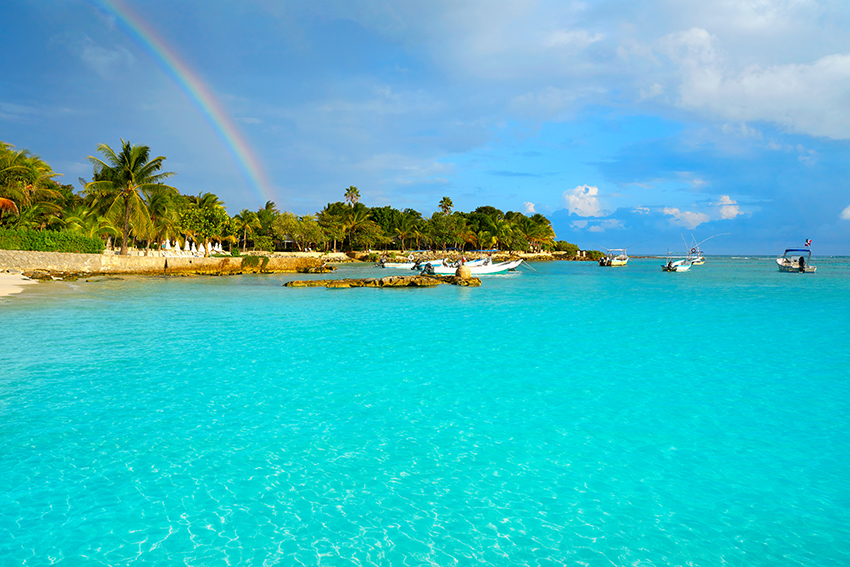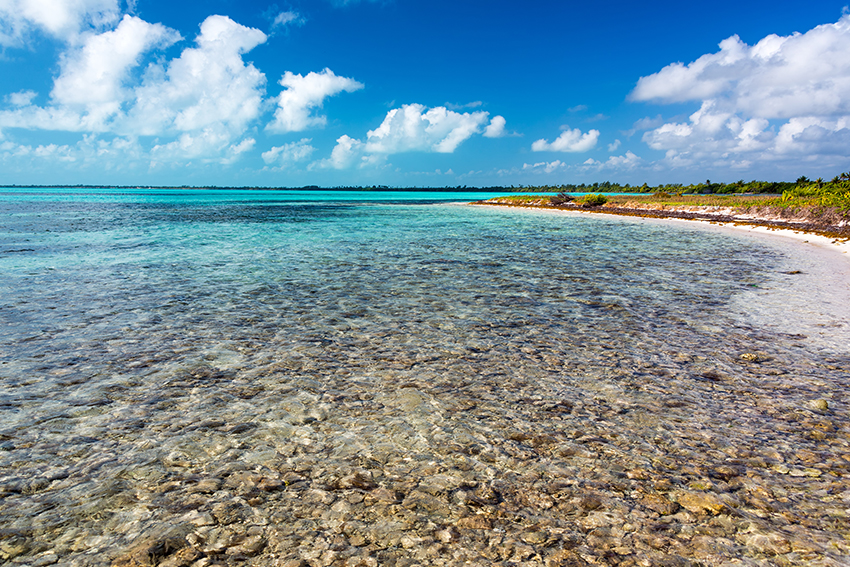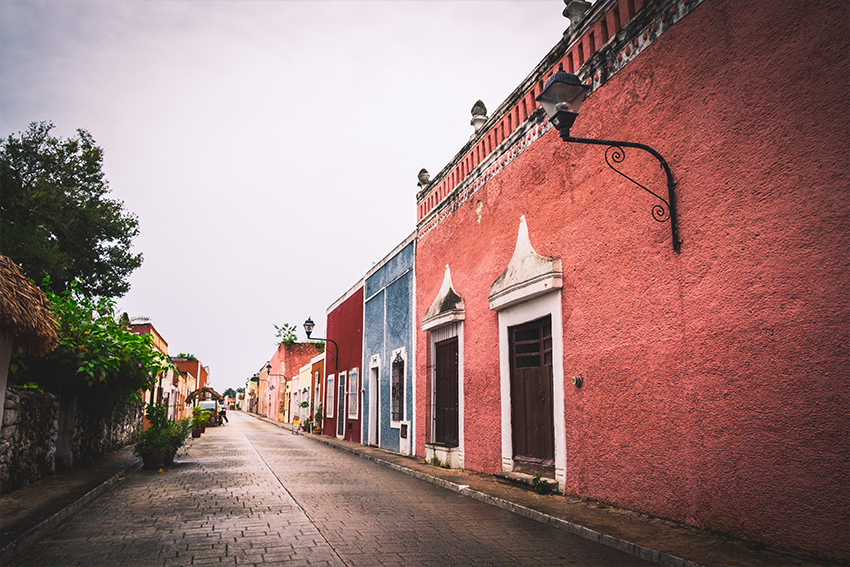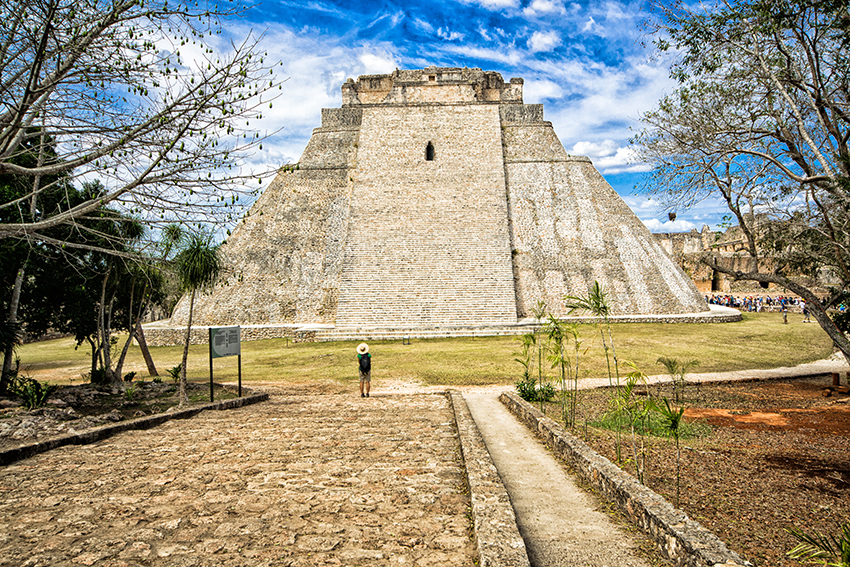Looking forward to your next visit to Cancun, this year why not plan to go somewhere new in the Riviera Maya and Yucatan? From beautiful beaches and coral reefs to jungle sinkholes and nature reserves, ancient Mayan temples to gracious old colonial cities, the area is full of incredible travel spots awaiting discovery. Here are some Riviera Maya and Yucatan trip ideas to get you started.
Akumal, place of the turtles
Ask longtime residents of the Mexican Caribbean to name their favorite beach and the odds are that many of them will say Akumal. This sheltered palm-lined bay in the Riviera Maya is a family favorite. Protected by a coral reef, the shallow waters are calm and crystal-clear, making it ideal for swimming and snorkeling.
Don your snorkeling mask and flippers in Akumal Bay and swim a few strokes away from the shoreline. You’ll soon start to see colorful reef fish and you may spot green turtles grazing on the beds of sea grass. Stay still and watch these beauties from a distance as they placidly glide by. In the Maya language Akumal means “place of the turtles” and they are everywhere you look here, in the water, on carved signs, as sweet wooden and pottery figurines and occupying pride of place in t-shirts and paintings by local artists. There’s even news that Akumal may soon have its own Sea Turtle Museum.
Head north along the coast road from Akumal Bay to Half Moon Bay, a rocky cove where the reef comes even closer to the shore. The snorkeling is good here too and the views are just as incredible. In fact, the water is so clear that you can sometimes see turtles coming up for air, rays breaching the surface and green and blue parrotfish swimming in the shallows.
Continue along the coast road to Caleta Yalku, a turquoise-colored inlet of crystal-clear waters constantly replenished by cenotes and underground rivers, hence the refreshingly cool temperature.The lagoon is a feeding and breeding ground for reef fish and one of the best snorkeling spots in the Riviera Maya. As soon as you climb down the wooden ladders into the water you’ll be surrounded by inquisitive sergeant majors, butterfly fish and blue tangs.
A local cooperative manages Yalku and charges a fee for admission. Life jackets are available and there are restrooms and a little open-air cafe. Try to get to Yalku early as it does tend to get quite crowded at midday.
Sian Ka’an Biosphere Reserve
Whether you drift along a channel in the mangroves where the only sound is the sigh of the breeze or follow a trail through the jungle in search of Mayan temples and rare wildlife, visiting Sian Ka’an Biosphere Reserve is an unforgettable adventure and one you shouldn’t miss if you are a nature lover.
Straddling northern and central Quintana Roo, Sian Ka’an is a huge reserve and UNESCO World Heritage Site protecting 1.3 million acres of tropical forest, mangroves, Caribbean beaches and a stretch of the Mesoamerican Reef.
Created by government decree in 1986, Sian Ka’an is home to 103 different mammals including the jaguar, peccary, tapir, howler and spider monkeys, and the West Indian manatee. It has one of Mexico’s largest crocodile populations and is an important nesting area for sea turtles. And yet its most visible treasures are birds, over 330 resident and migratory species have been registered here in the jungle and wetlands.
When you explore the wetlands you’ll spot up to 16 varieties of heron, roseate spoonbills, flocks of wood storks and ibis. Flamingos are occasional winter visitors and pelicans, frigate birds, cormorants and kingfishers nest in the mangroves. The jungle is home to species ranging from hummingbirds to parrots, keel-billed toucans and collared aracaris, trogons, turquoise-browed motmots and chachalacas.
Sian Ka’an means “where the sky is born in Maya” and the ancient Maya hunted, fished and traveled the wetlands. Muyil is the largest of the 23 archaeological sites found to date in the reserve and many boat trips through the wetlands depart from the neighboring lagoon of the same name. Boats make their way along a canal through the mangroves that was dredged by the ancient Maya so that their trading canoes could sail from the Caribbean coast inland to Muyil.
Other Muyil trips include a look at the production of chicle, the original natural ingredient for chewing gum, which has been harvested by the Maya in the forests of southeast Mexico for thousands of years. Chicleros or harvesters cut the bark of the chicozapote tree with machetes and collect the white sap as it trickles down the trunk from the v-shaped gashes. The sap is then boiled and shaped into balls or blocks and processed for use in natural chewing gum.
Another option is to make your way to Punta Allen, a fishing village on the shores of Bahia de la Asuncion for fishing, diving, birding, bike trips and nature walks offered by Maya Ka’an community tour operators.
Valladolid
An easy one-and-a-half hour drive from Cancun, the colonial town of Valladolid is the perfect spot to spend the day learning about the history and traditions of the Yucatan and sampling local cuisine.
Stroll through the tree-lined main square, which is dominated by the 17th-century San Servacio Church and the Town Hall. Located behind the Town Hall, the San Roque Museum has exhibits on the history of Valladolid from the days of the ancient Maya to the Spanish Conquest, Colonial period, 19th-century Caste War and the Mexican Revolution.
Just a half block from the main square is Casa de Los Venados, a restored colonial mansion that is a private home and museum with an incredible collection of more than 3,000 pieces of Mexican folk art. The collection includes handwoven textiles from Oaxaca, Chiapas, Puebla and Hidalgo, huge ceramic trees of life, saints and jaguars, Day of the Dead art, Talavera pottery, sculptures, wood carvings, prize winning masks and piñatas and much more. There are guided tours at 10 a.m. (Valladolid time) and visitors are asked to make a donation in support of local charitable causes.
Next stop is Calzada de Los Frailes, a street lined with restored colonial houses that takes you as far as the sprawling San Bernardino Church and Sisal Convent. En route be sure to call in at La Casona to see the shrine honoring the Virgen de la Candelaria, the patron saint of Valladolid; the statue with its fountains is a mosaic made from fragments of Talavera pottery by craftsmen working at Xcaret Park.
Having already seen impressive Mexican textiles, ceramics, alebrije figurines and more in Casa de Los Venados you’ll be ready to start shopping for your own Mexican collection. There are several craft stores in the main square (one with its own chocolate workshop where you can watch cacao being ground) and a community craft center where you can pick up embroidered cotton dresses, blouses and shirts, leather and more. More stores await you on Calzada de Los Frailes, including the Coqui Coqui perfumery.
There are more colonial churches in the town’s barrios or neighborhoods and you should also visit the Zaci Cenote, a huge sinkhole with cliffs covered with ferns, vines and tree roots. Bats, swifts and motmots make their nests in the limestone and the clear turquoise water is a magnet for local children. There are many more of these mysterious natural wells to visit in the Valladolid area, the most famous of which are Dzitnup and Samula.
Before you leave Valladolid, call in at the Mayapan Distillery where the blue agave plant is harvested, cooked, crushed and the sugary sap distilled using traditional artisanal techniques to make a tequila-like spirit.
Valladolid is one of the Yucatan’s Pueblos Magicos (Izamal is the other), part of a Mexico Tourism Board program to promote smaller and lesser known villages and towns throughout the country that owe their magic to traditions, pre-Hispanic or colonial architecture or outstanding natural beauty.
Uxmal, a Mayan masterpiece
You may have been to Chichen Itza, the Yucatan’s famous World Heritage Site, but have you visited Uxmal, its rival in majesty? An hour’s drive south of Merida, Uxmal is one of the loveliest ancient cities in the Maya World and is a masterpiece of art and architecture. During the Late Classic period of Mayan history (A.D. 600-900), it was a regional capital, controlling southwest Yucatán and a chain of smaller cities known as the Puuc Route: Kabah, Sayil, Xlapak and Labná.
Apart from location, these sites share a unique architectural and artistic style called Puuc. In recognition of their outstanding cultural worth, UNESCO declared them a World Heritage area in 1996.
Towering above the forest, the Magician’s Pyramid dominates the skyline at Uxmal. A maze of small temples behinds it leads you to the Nuns’ Quadrangle, a gracious courtyard surrounded by four palaces with magnificent friezes featuring masks of the rain god Chaac, snakes, birds and warriors.
Equally impressive is the Palace of the Governor crowning a temple mound with a panoramic view of the site. The House of the Turtles, the Great Pyramid, and El Palomar lie nearby.
You can combine a visit to Uxmal with a trip to the Yucatan capital Merida or head south from Uxmal to visit the other archaeological sites on the Puuc Route, the Loltun Caves and colonial towns such as Ticul and Mani and Oxkutzcab on the Convent Route.
Go off the beaten track with a private tour
Book your own driver and guide for the day and let Thomas More Travel take care of everything. Private tours are a great way to go off the beaten track in the Riviera Maya and Yucatan and visit archaeological sites, colonial towns and rural communities or your own beach hopping getaway. If you already know where you want to go you’ll be able to drive straight there, if not, travel desk staff will be happy to help you create an unforgettable sightseeing itinerary.
Thomas More Travel, your vacation guide
Visit www.thomasmoretravel.com to book tours in the Riviera Maya and Yucatan for this year’s Cancun vacation and be sure to visit the travel desks during your stay at Royal Resorts for more ideas.




